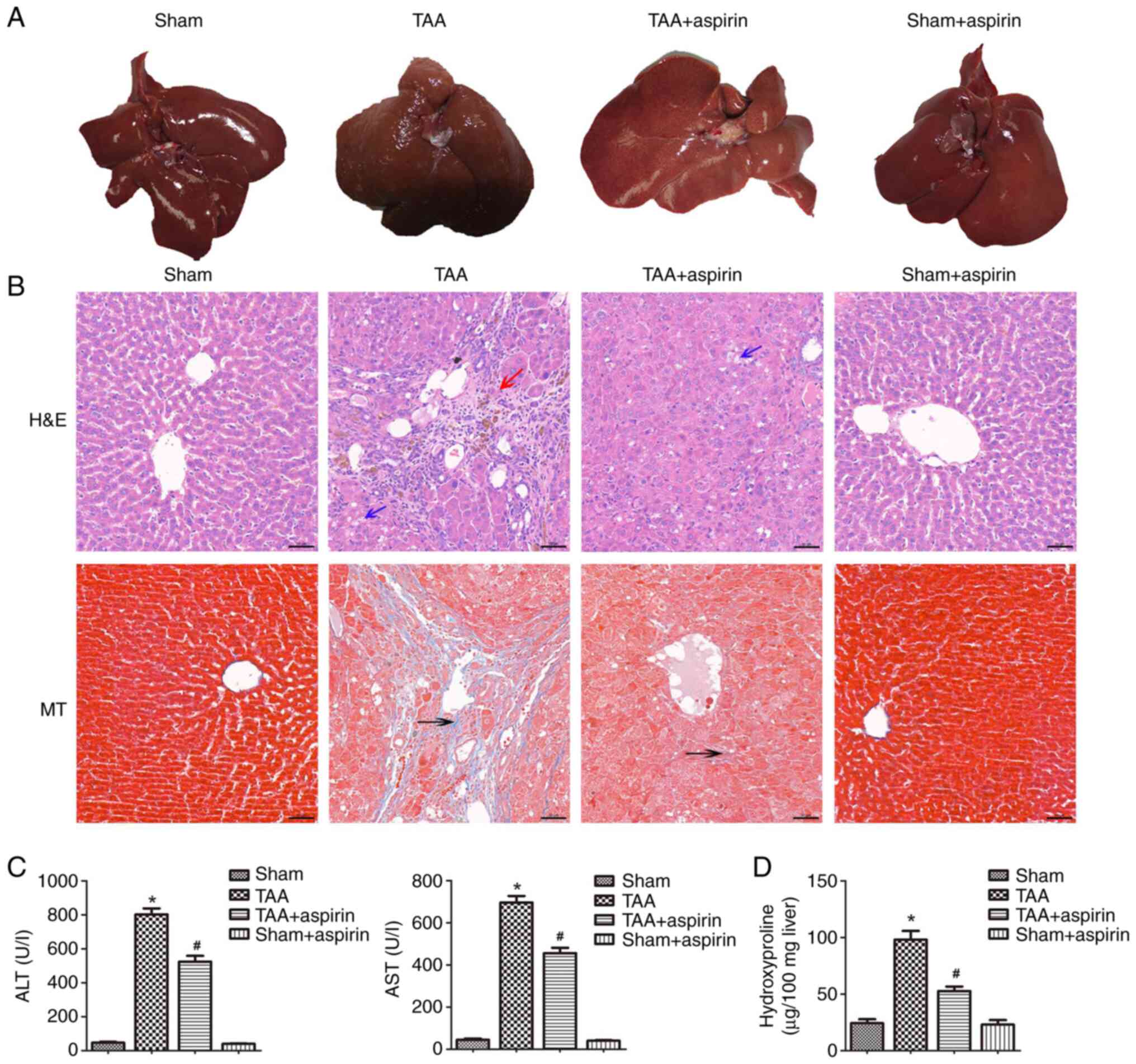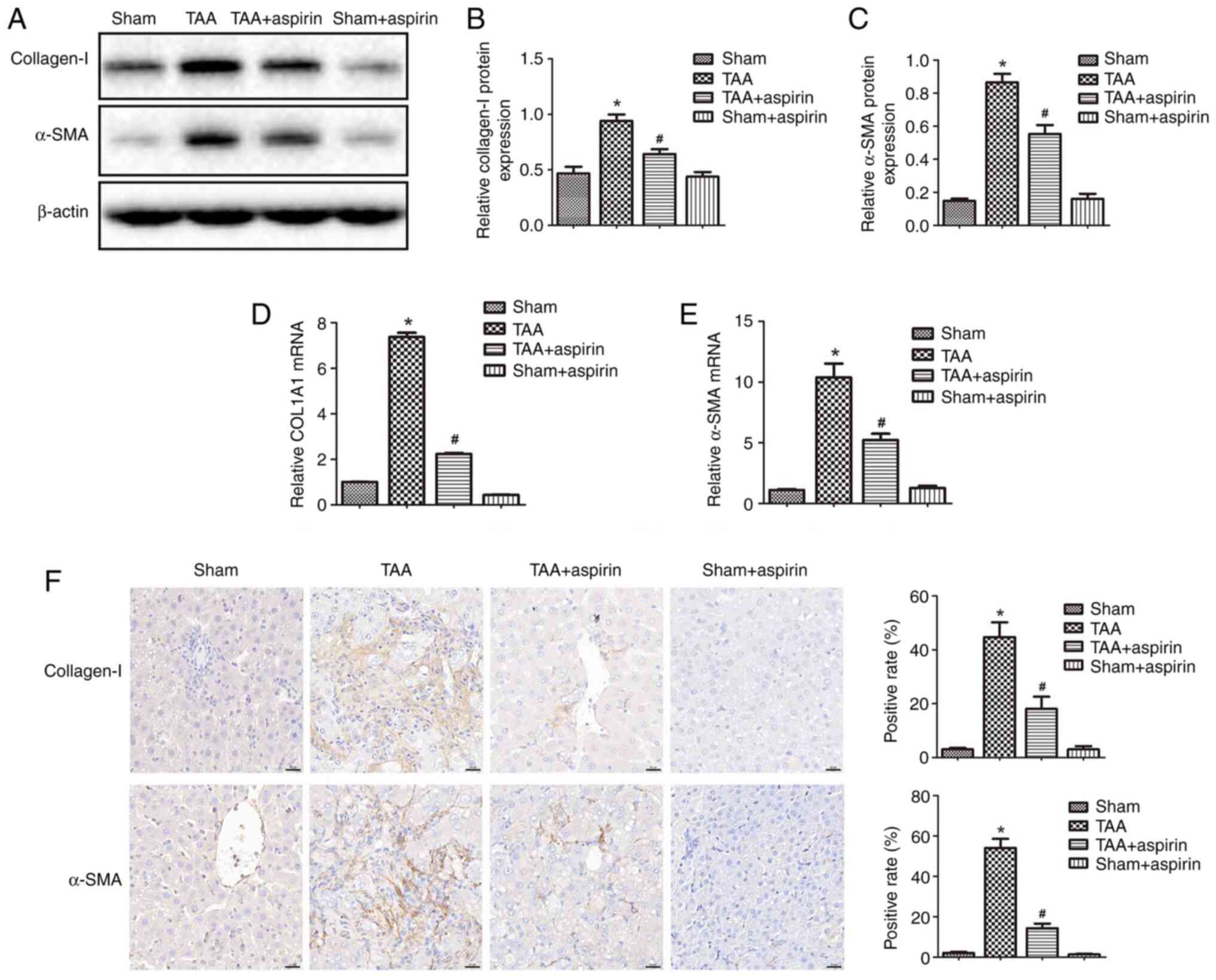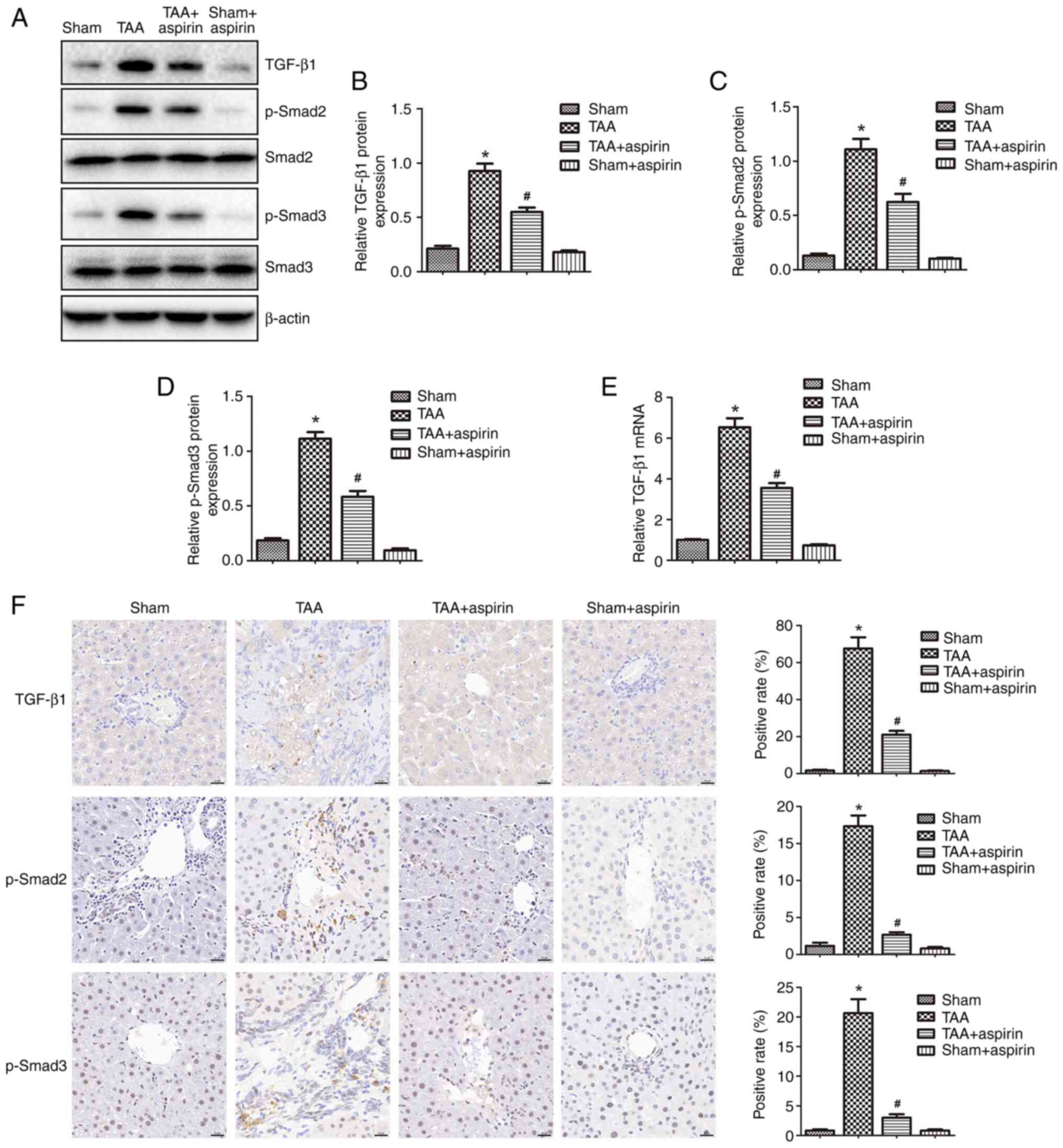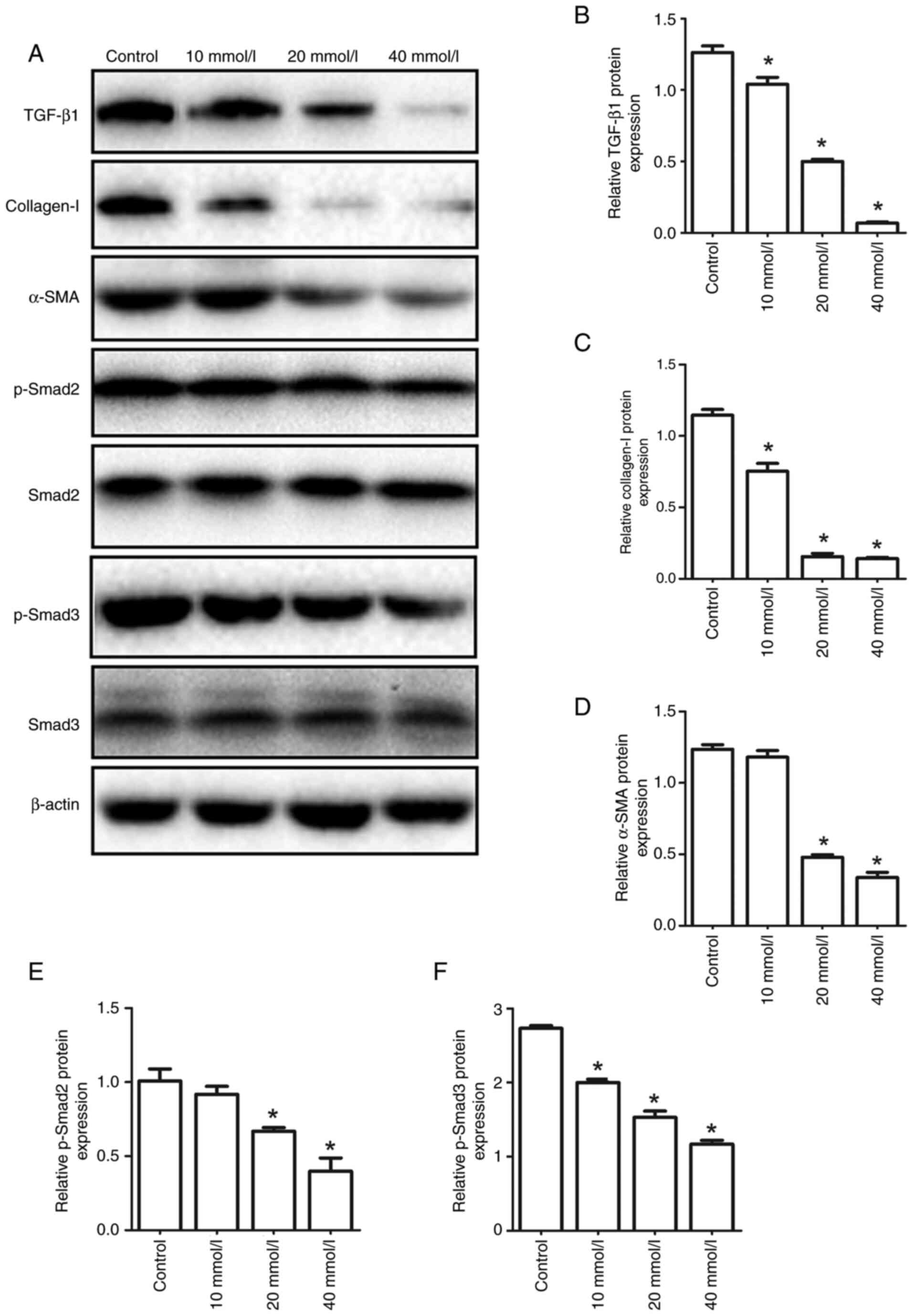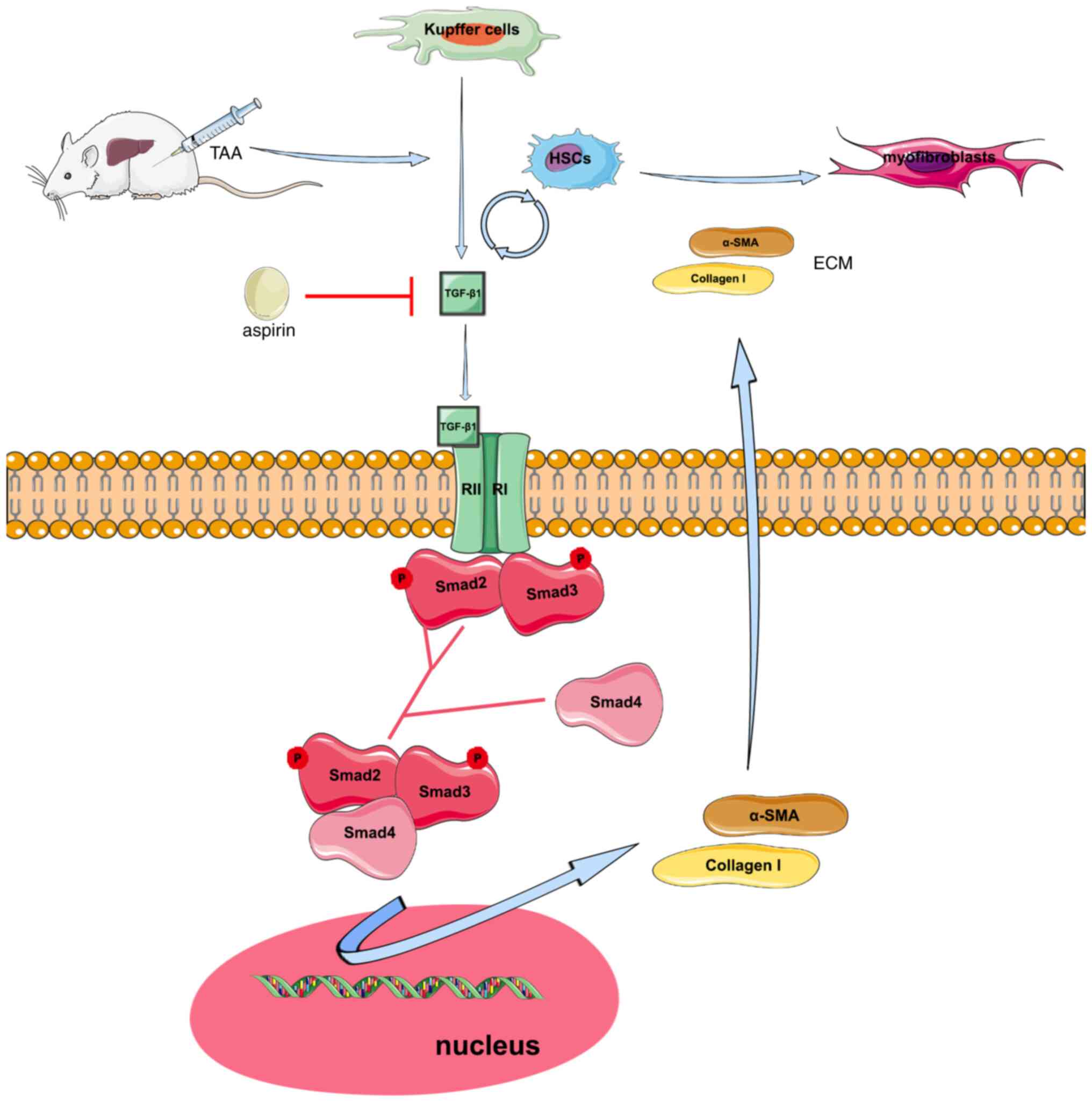Aspirin attenuates liver fibrosis by suppressing TGF‑β1/Smad signaling
- Authors:
- Published online on: March 23, 2022 https://doi.org/10.3892/mmr.2022.12697
- Article Number: 181
-
Copyright: © Sun et al. This is an open access article distributed under the terms of Creative Commons Attribution License.
Abstract
Introduction
Liver fibrosis is the result of a healing response to a variety of injury factors, such as chronic hepatitis, cholestasis, alcohol and drugs. It has been reported that liver fibrosis serves a significant role in the development of liver cirrhosis and liver cancer (1,2). When the liver is damaged, the injured hepatocytes, Kupffer cells or inflammatory cells produce several endogenous profibrotic cytokines or proinflammatory factors, which in turn activate resting hepatic stellate cells (HSCs). Activated HSCs undergo collagen overproduction, while collagen degradation is inhibited, eventually leading to the accumulation of extracellular matrix (ECM). ECM is considered to be the main pathophysiological process leading to liver fibrosis (3). Liver fibrosis has recently become the main focus in numerous studies. Unfortunately, safe and effective anti-fibrotic drugs are still lacking (4). Therefore, further studies on the development of effective drugs for treating liver fibrosis are urgently required.
TGF-β1 plays an important role in liver fibrosis (5–7). Activated HSCs secrete TGF-β1 and differentiate into myofibroblasts, which in turn promote the synthesis and accumulation of ECM-related proteins leading to liver fibrosis. Additionally, TGF-β1 can also activate HSCs, which further increase the synthesis and secretion of TGF-β1, thereby promoting the development of liver fibrosis (8). Furthermore, another study revealed that TGF-β1 enhanced ECM by regulating the TGF-β/Smad signaling pathway to further promote the development of fibrosis (6).
Aspirin is a common non-steroidal anti-inflammatory drug, also known as acetylsalicylic acid; it is most commonly used to decrease fever, relieve pain and attenuate inflammatory responses (9). However, it is also used to improve the cardiovascular system (10), central nervous system (11) and even certain types of cancer (12,13). Emerging evidence has suggested that aspirin exhibits notable antifibrotic effects on liver diseases. For example, aspirin significantly reduced the liver fibrosis index in US adults with chronic liver diseases (14). Additionally, aspirin was found to attenuate the degree of hepatic fibrosis in a liver fibrosis rat model (15). Nevertheless, the mechanism underlying the effect of aspirin on regulating hepatic fibrosis remains elusive. A recent study showed that aspirin could alleviate liver fibrosis in rats by inhibiting the toll-like receptor 4/NF-κB signaling pathway (16), although the effect of aspirin on liver fibrosis by inhibiting the TGF-β1/Smad pathway has not been previously investigated.
Therefore, in the present study, a rat model of hepatic fibrosis was established by intraperitoneal injection of thioacetamide (TAA) to evaluate the antifibrotic effect of aspirin. In addition, the study further explored whether aspirin could attenuate liver fibrosis through the TGF-β1/Smad signaling pathway and the effects of aspirin on HSC collagen production, thus uncovering the molecular mechanism underlying the protective effect of aspirin against liver fibrosis. The results of the present study may provide further knowledge for the use of aspirin in the treatment of hepatic fibrosis.
Materials and methods
Drugs
TAA was obtained from MilliporeSigma, while aspirin was purchased from Bayer AG.
Animals
A total of 30 healthy male Sprague-Dawley (SD) rats (age, 6 weeks), weighing 200–220 g, were obtained from the Experimental Animal Center of the Tongji Medical College, Huazhong University of Science and Technology (Wuhan, China). The animals were maintained under a 12 h light/dark cycle at room temperature (20–25°C) and a humidity of 50–60%. All animals had free access to food and water. The animal experiments were approved by the Ethics Committee of Animal Experiments of the Tongji Medical College (Wuhan, China; approval no. TJ-A20150803).
Cell culture
The rat HSC line, HSC-T6 (cat. no. CL-0116), was purchased from the Shanghai Institute of Biochemistry and Cell Biology, and was cultured in high-glucose DMEM supplemented with 10% FBS (both from Gibco; Thermo Fisher Scientific, Inc.), 100 µg/ml penicillin and 100 µg/ml streptomycin (Beyotime Institute of Biotechnology) at 37°C in a 5% CO2 incubator. HSCs were treated with different concentrations of aspirin (10, 20 and 40 mmol/l) at 37°C for 72 h, as previously described (16).
Biochemical analyses
Serum was isolated from rat blood samples at 1,200 × g for 5 min at 4°C and the serum levels of aspartate transaminase (AST) and alanine transaminase (ALT) were measured using the corresponding AST (cat. no. C010-2-1; Nanjing Jiancheng Bioengineering Institute) and ALT (cat. no. C009-2-1; Nanjing Jiancheng Bioengineering Institute) commercial kits, according to the manufacturer's instructions. The levels of hepatic hydroxyproline were measured using a hydroxyproline test kit (cat. no. A030-2-1; Nanjing Jiancheng Bioengineering Institute), according to the manufacturer's protocol.
TAA-induced liver fibrosis and aspirin treatment
SD rats were randomly divided into four groups (n=7/group). Rats in the TAA and TAA + aspirin groups received 200 mg/kg intraperitoneal TAA twice weekly for 8 weeks, while 1 ml physiological saline and 1 ml aspirin (30 mg/kg), respectively, were administered by gavage once every morning for 8 weeks (15). In addition, rats in the sham + aspirin group were treated with saline and aspirin as aforementioned. However, rats in the sham group were treated with intraperitoneal saline twice weekly for 8 weeks and then an additional 1 ml physiological saline was administered by gavage once every morning over a period of 8 weeks. At the end of the eighth week, 72 h after the last TAA injection, all animals were anaesthetized with 200 mg/kg intraperitoneal sodium pentobarbital and sacrificed by cervical dislocation. All animal experiments in the present study were performed in accordance with the Guide for the Care and Use of Laboratory Animals. Blood was collected by cardiac puncture and livers were subsequently removed. Liver and blood samples were collected and stored at −80°C for further analysis.
Histopathological and immunohistochemical (IHC) analysis
Liver tissues were fixed in 4% paraformaldehyde solution at 4°C for 24 h and embedded in paraffin. Paraffin-embedded tissue samples were cut into 4-µm thick sections followed by staining with H&E (hematoxylin 5 min, eosin 3 min) and Masson's trichrome (Wuhan Servicebio Technology Co., Ltd.) for 15 min at room temperature according to the manufacturer's protocol. Subsequently, the tissue sections were deparaffinized with xylene and rehydrated in gradient ethanol at room temperature. For antigen retrieval, the tissue was boiled in a microwave for 15 min and washed with PBS. The tissue sections were blocked with 10% bovine serum albumin (Beijing Dingguo Changsheng Biotechnology Co., Ltd.) for 15 min at room temperature and were then incubated overnight at 4°C with the following primary antibodies: Rabbit anti-TGF-β1 (dilution 1:1,000; cat. no. 21898-1-AP; Wuhan Sanying Biotechnology), rabbit anti-collagen I (dilution 1:500; cat. no. ab34710; Abcam), rabbit anti-α-smooth muscle actin (α-SMA) (dilution, 1:500; cat. no. ab32575; Abcam), rabbit anti-phosphorylated (p)-Smad2 (dilution 1:500; cat. no. 3108; Cell Signaling Technology, Inc.) and rabbit anti-p-Smad3 (dilution 1:500; cat. no. 1880-1; Epitomics; Abcam). Following rinsing in PBS, the tissue sections were incubated with horseradish peroxidase-conjugated goat anti-rabbit IgG (1:500; cat. no. PV-9001; Beijing Zhongshan Golden Bridge Biotechnology Co., Ltd.) secondary antibody for 1 h at 37°C, followed by staining with 0.05% diaminobenzidine for 90 sec and counterstaining with hematoxylin for 5 min at room temperature. Finally, the tissue sections were dehydrated again in gradient ethanol and mounted with neutral rubber (17). Representative images in three randomly selected fields per slide were captured under the Nikon Digital ECLIPSE C1 confocal microscope (Nikon Corporation). The positive staining to total area ratios were calculated using the Image-Pro Plus 6.0 imaging software (Media Cybernetics, Inc.). The average value from three ratios was used for statistical analysis.
Western blot analysis
Total protein was extracted from liver tissue and HSCs using RIPA buffer supplemented with protease inhibitors (Beyotime Institute of Biotechnology). The protein concentration was measured using BCA and 40 µg protein/lane was separated by SDS-PAGE on a 8–10% gel and then transferred onto a PVDF membrane. Following blocking with 5% skimmed milk in TBS at room temperature for 1 h, the membranes were incubated overnight at 4°C with the following primary antibodies: Rabbit anti-TGF-β1 (dilution 1:500; cat. no. 21898-1-AP; Wuhan Sanying Biotechnology), rabbit anti-collagen I (dilution, 1:500; cat. no. ab34710; Abcam), rabbit anti-α-SMA (dilution 1:500; cat. no. ab32575; Abcam), rabbit anti-p-Smad2 (dilution 1:1,000; cat. no. 3108; Cell Signaling Technology, Inc.), rabbit anti-Smad2 (dilution 1:500; cat. no. 1641-1), rabbit anti-p-Smad3 (dilution, 1:1,000; cat. no. 1880-1) and rabbit anti-Smad3 (dilution, 1:500; cat. no. 1735-1) (all from Epitomics; Abcam) and rabbit anti-β-actin (dilution 1:1,000; cat. no. sc-47778; Santa Cruz Biotechnology, Inc.). Following washing with TBS containing 0.1% Tween-20, the membranes were incubated with horseradish peroxidase-conjugated goat anti-rabbit IgG secondary antibodies (dilution 1:5,000; cat. no. ZB-5301; Beijing Zhongshan Golden Bridge Biotechnology Co., Ltd.) for 1 h at room temperature. The immunoreactive bands were visualised using an ECL reagent (Thermo Fisher Scientific, Inc.) and detected using the ChemiDoc™ Imaging System (Bio-Rad Laboratories, Inc.).
Reverse transcription-quantitative PCR (RT-qPCR)
Total RNA was extracted from liver tissues using TRIzol® reagent (Invitrogen; Thermo Fisher Scientific, Inc.). A SMA2000 spectrophotometer (Thermo Fisher Scientific, Inc.) was used to measure RNA absorbance at 260 nm. Next, the PrimeScript® RT reagent kit (Takara Biotechnology Co., Ltd.) was used for reverse transcription. The transcriptional conditions were 37°C for 15 min and 98°C for 5 min, followed by maintenance at 4°C. qPCR was performed using the SYBR Green PCR Master Mix-PLUS kit (Toyobo Life Science) on the CFX96 Touch™ Real-Time PCR Detection System (Bio-Rad, Laboratories, Inc.). Each 20-µl reaction contained 10 µl SYBR Green Mix, 6 µl nuclease-free H2O, 2 µl cDNA, 1 µl upstream primer and 1 µl downstream primer. The thermocycling conditions for qPCR were as follows: Initial denaturation at 95°C for 60 sec, followed by 40 cycles of 95°C for 15 sec, 60°C for 15 sec and extension at 72°C for 45 sec. The primer sequences were synthesized by Sangon Biotech Co., Ltd. The relative mRNA expression levels were calculated with the 2−ΔΔCq method (18). GAPDH served as an internal reference gene. The primer sequences used are listed in Table I.
Statistical analysis
All experimental data are expressed as the mean ± SEM of three independent experiments. Comparisons among multiple groups were performed with one-way ANOVA followed by Tukey's post hoc test. All graphs were constructed by GraphPad Prism 5.0 software (GraphPad Software, Inc.). All statistical analyses were performed using SPSS 22.0 software (IBM Corp.). P<0.05 was considered to indicate a statistically significant difference.
Results
Aspirin attenuates TAA-induced liver fibrosis in a rat model
The livers in the sham and aspirin groups of the in vivo rat model appeared bright red, soft, smooth and sharp-edged at the eighth week after treatment (Fig. 1A). By contrast, the livers in the TAA group were dark red, hard, rough with granular nodules and blunt-edged (Fig. 1A). The livers in the TAA + aspirin group were more yellow and slightly harder compared with those in the sham and sham + aspirin group. However, livers in the TAA + aspirin group were softer compared with those in the TAA group, while no granular nodules were observed (Fig. 1A). Subsequently, H&E and Masson's staining were performed to evaluate the degree of liver fibrosis. Liver tissues derived from rats in the TAA group had pathological changes, with hepatic steatosis and fat vacuoles, while the liver lobule structure was abnormal or damaged as shown by H&E staining. Masson's staining showed a marked increase in collagen and the formation of pseudolobules (Fig. 1B). However, the aforementioned damaged tissues and fibrotic areas were marked improved in the TAA + aspirin group (Fig. 1B). To evaluate the effect of aspirin on liver injury, the levels of AST and ALT in the serum were detected. As shown in Fig. 1C, the serum levels of AST and ALT were significantly increased in the TAA group compared with that in the sham group. However, the levels of both AST and ALT were significantly decreased in the TAA + aspirin group compared with that in the TAA group indicating that aspirin attenuated TAA-induced liver injury. Furthermore, hydroxyproline, a marker of total hepatic collagen content, was significantly increased in the TAA group compared with that in the sham group, and then decreased in the TAA + aspirin group compared with that in the TAA group (Fig. 1D). Additionally, the results demonstrated that the protein and mRNA expression levels of α-SMA and collagen I were upregulated in the TAA group compared with those in the sham group, and then downregulated again in the TAA + aspirin group compared with those in the TAA group (Fig. 2A-E). Additionally, IHC staining was performed to analyze the expression levels of α-SMA and collagen I in the liver tissue. The results showed enhanced staining of α-SMA and collagen I in the TAA group, which was then decreased in the TAA + aspirin group (Fig. 2F). The aforementioned findings suggested that aspirin could attenuate TAA-induced hepatic fibrosis in rats.
Aspirin attenuates liver fibrosis by regulating the TGF-β1/Smad signaling pathway
To explore the mechanisms underlying the effect of aspirin on inhibiting liver fibrosis, the protein expression levels of TGF-β1, p-Smad2, p-Smad3, Smad2 and Smad3 were determined by western blotting and IHC staining (Fig. 3). The results showed that the protein expression levels of TGF-β1, p-Smad2 and p-Smad3 were significantly increased in the TAA group compared with those in the sham group, while they were significantly reduced in the TAA + aspirin group compared with those in the TAA group. No changes were observed in the protein levels of total Smad2 and Smad3 (Fig. 3A-D and F). In addition, treatment with aspirin significantly decreased the mRNA levels of TGF-β1 (Fig. 3E). These findings indicated that aspirin could attenuate liver fibrosis by inhibiting the TGF-β1/Smad signaling pathway.
In vitro effect of aspirin on HSCs
To further investigate whether the antifibrotic effect of aspirin was triggered by regulating the TGF-β1/Smad signaling pathway in HSCs, HSCs were treated with different concentrations of aspirin. As shown in Fig. 4, aspirin downregulated the protein expression levels of α-SMA, collagen I, TGF-β1, p-Smad2 and p-Smad3 in a dose-dependent manner. These results were consistent with the observations in the rat model of liver fibrosis.
Discussion
Liver fibrosis, characterized by increased deposition of ECM, is the repair and healing process during liver injury caused by various factors (19). However, this process is also associated with the transformation of chronic liver diseases into cirrhosis and liver cancer (20). Currently, there are no safe and effective drugs for the treatment of liver cirrhosis. Most drugs can only reduce complications, but they cannot treat the underlying cause of liver fibrosis. Therefore, further studies on the development of novel antifibrotic treatments are urgently needed to prevent and/or reverse liver fibrosis. Although it has been reported that aspirin exhibits antifibrotic effects, the mechanism underlying the effect on hepatic fibrosis remains elusive. The present study revealed that aspirin attenuated liver fibrosis by suppressing TGF-β1/Smad signaling in rats.
Within the present study, a rat model of liver fibrosis was established using TAA. A previous study demonstrated that the liver morphology and function in TAA-induced liver fibrosis rats is similar to that in humans (21). In the present study, treatment of rats with TAA significantly increased the levels of AST and ALT in the serum. A recent study revealed that the enhanced levels of AST and ALT, two common markers of liver injury (22), were associated with disruption of hepatocyte membrane integrity or hepatocyte injury (23). In the present study, the results of H&E and Masson's staining revealed the onset of typical fibrosis-related pathological changes in the livers of rats treated with TAA for 8 weeks. Consistent with previous studies (15,24), the treatment of rats with aspirin alleviated the pathological changes in the liver, thus indicating that aspirin could exert an antifibrotic effect and improve liver injury.
Emerging evidence has suggested that the activation of HSCs plays an important role in liver fibrosis. Once the liver is injured, quiescent HSCs are activated and differentiate into myofibroblasts, which express high levels of α-SMA, collagen I and collagen III, thus resulting in an increased deposition of ECM and the development of liver fibrosis (25). Profibrogenic cytokines, such as TGF-β1 and TNF-α, also play a critical role in the progress of liver fibrosis (26). Liver injury induces Kupffer cells to produce TGF-β1 (27). In addition, another study showed that HSCs could be activated by TGF-β1 and differentiate into myofibroblasts to further promote the development of fibrosis (28). The present study demonstrated that the expression levels of TGF-β1, p-Smad2, p-Smad3, collagen I and α-SMA were significantly increased in the TAA-induced liver fibrosis model, and then significantly reduced following aspirin treatment. Furthermore, aspirin downregulated the protein expression levels of TGF-β1, p-Smad2, p-Smad3, collagen I and α-SMA in HSCs. The in vitro results were consistent with those observed in vivo. These results suggested that aspirin could attenuate liver fibrosis by inhibiting the TGF-β1/Smad signaling pathway.
A recent study showed that aspirin downregulated TGF-β1 in a carbon tetrachloride-induced chronic liver injury model (29). TGF-β1 is a significant mediator of liver fibrosis. TGF-β1 is secreted by Kupffer cells, activated in HSCs and specific inflammatory cells (30). TGF-β1 activates resting HSCs, which in turn secrete more TGF-β1 to maintain the activation status of these cells, thus enhancing ECM deposition (31). TGF-β1 binds to type I and type II TGF-β receptors (TβRs) on the surface of HSCs, while the intracellular signal transduction of TGF-β1 is mediated by the Smad protein family. When TGF-β1 is activated, it binds to TβRII on the surface of HSCs to activate TβRI. In turn, activated TβRI primarily induces the phosphorylation of Smad2 and Smad3 in quiescent and activated HSCs, respectively (32). Subsequently, activated Smad2/3 bind to Smad4 and the complex translocates into the nucleus to activate the transcription of downstream genes, inducing liver fibrosis-related genes such as fibronectin, α-SMA and collagen I (33,34). Previous studies suggested that the increased expression of fibronectin, α-SMA and collagen I in liver fibrosis could be associated with the TGF-β1/Smad signaling pathway (35,36). The aforementioned molecules could alleviate liver fibrosis in rats by inhibiting the TGF-β1 signaling pathway (37). The present study explored the effect of aspirin on the TGF-β1/Smad signaling pathway. The results showed that treatment with TAA increased TGF-β1 levels, which were restored following treatment with aspirin. Accordingly, aspirin reduced the expression levels of the downstream molecules p-Smad2 and p-Smad3. Therefore, these results indicated that aspirin could effectively inhibit the TGF-β1/Smad signaling pathway involved in liver fibrosis.
Aspirin alleviated TAA-induced liver fibrosis in rats. Therefore, treatment with aspirin reduced the secretion of TGF-β1 by activated HSCs and Kupffer cells, thus resulting in p-Smad2, p-Smad3, α-SMA and collagen I downregulation by the TGF-β1/Smad signaling pathway. Additionally, reduction of TGF-β1 reduced the activation of HSCs and myofibroblasts and attenuated ECM production (Fig. 5).
The present study contains some limitations. First, the results showed that aspirin alleviated TAA-induced liver fibrosis in rats. However, there are also other liver fibrosis models with different underlying mechanisms, such as the bile duct ligation-induced liver fibrosis model. Therefore, the mechanism underlying the antifibrotic effect of aspirin should be also investigated in such models. Second, a previous study indicated that aspirin activates AMP-activated protein kinase and upregulates Smad 6 in FOP fibroblast cells (38). However, whether Smad 6, as a key negative regulator of the TGF-β1/Smad signaling pathway, is involved in the antifibrotic effects of aspirin should be further investigated. Third, the present study revealed that aspirin alleviated TAA-induced liver fibrosis. However, the underlying mechanism of aspirin with regard to improving liver fibrosis was only preliminarily investigated. Therefore, additional studies are required to further investigate the involvement of the TGF-β1/Smad signaling pathway in the antifibrotic effect of aspirin.
In summary, the present study suggested that aspirin could exert a potential protective role against liver fibrosis. The present study was the first to demonstrate that aspirin could ameliorate TAA-induced liver fibrosis by inhibiting the TGF-β1/Smad signaling pathways. These results indicated that aspirin could provide novel insights into the development of new drugs for the prevention and treatment of liver fibrosis. Furthermore, the safety of aspirin in clinical practice and other mechanisms remain to be studied.
Acknowledgements
Not applicable.
Funding
This work was supported by the Health and Family Planning Research Foundation of Hubei Province of China (grant no. WJ2016-Y-26).
Availability of data and materials
The datasets used and/or analyzed during the current study are available from the corresponding author on reasonable request.
Authors' contributions
YS and BL designed and performed the experiments, designed the figures and drafted the manuscript. JXie, XJ, BX and XH performed the experiments. JXia designed the experiments, analyzed the data, and critically revised the manuscript for important intellectual content. All authors read and approved the final manuscript. YS and JXia confirm the authenticity of all the raw data.
Ethics approval and consent to participate
All animal experiments were approved by the Ethics Committee of Animal Experiments of the Tongji Medical College (approval no. TJ-A20150803).
Patient consent for publication
Not applicable.
Competing interests
The authors declare that they have no competing interests.
References
|
Friedman SL: Liver fibrosis-from bench to bedside. J Hepatol. 38 (Suppl 1):S38–S53. 2003. View Article : Google Scholar : PubMed/NCBI | |
|
Friedman SL: Seminars in medicine of the Beth Israel Hospital, Boston. The cellular basis of hepatic fibrosis. Mechanisms and treatment strategies. N Engl J Med. 328:1828–1835. 1993. View Article : Google Scholar : PubMed/NCBI | |
|
Kisseleva T and Brenner DA: Role of hepatic stellate cells in fibrogenesis and the reversal of fibrosis. J Gastroenterol Hepatol. 22 (Suppl 1):S73–S78. 2007. View Article : Google Scholar : PubMed/NCBI | |
|
Friedman SL: Evolving challenges in hepatic fibrosis. Nat Rev Gastroenterol Hepatol. 7:425–436. 2010. View Article : Google Scholar : PubMed/NCBI | |
|
Szabo G and Bala S: Alcoholic liver disease and the gut-liver axis. World J Gastroenterol. 16:1321–1329. 2010. View Article : Google Scholar : PubMed/NCBI | |
|
Zhang D, Hao X, Xu L, Cui J, Xue L and Tian Z: Intestinal flora imbalance promotes alcohol-induced liver fibrosis by the TGFβ/smad signaling pathway in mice. Oncol Lett. 14:4511–4516. 2017. View Article : Google Scholar : PubMed/NCBI | |
|
Yang Y, Kim B, Park YK, Koo SI and Lee JY: Astaxanthin prevents TGFβ1-induced pro-fibrogenic gene expression by inhibiting Smad3 activation in hepatic stellate cells. Biochim Biophys Acta. 1850:178–185. 2015. View Article : Google Scholar : PubMed/NCBI | |
|
Liu Q, Duan ZP, Ha DK, Bengmark S, Kurtovic J and Riordan SM: Synbiotic modulation of gut flora: Effect on minimal hepatic encephalopathy in patients with cirrhosis. Hepatology. 39:1441–1449. 2004. View Article : Google Scholar : PubMed/NCBI | |
|
Vonkeman HE and van de Laar MA: Nonsteroidal anti-inflammatory drugs: Adverse effects and their prevention. Semin Arthritis Rheum. 39:294–312. 2010. View Article : Google Scholar : PubMed/NCBI | |
|
Berk M, Woods RL, Nelson MR, Shah RC, Reid CM, Storey E, Fitzgerald S, Lockery JE, Wolfe R, Mohebbi M, et al: Effect of aspirin vs. placebo on the prevention of depression in older people: A randomized clinical trial. JAMA Psychiatry. 77:1012–1020. 2020. View Article : Google Scholar : PubMed/NCBI | |
|
Antman EM: Evaluating the cardiovascular safety of nonsteroidal anti-inflammatory drugs. Circulation. 135:2062–2072. 2017. View Article : Google Scholar : PubMed/NCBI | |
|
Henry WS, Laszewski T, Tsang T, Beca F, Beck AH, McAllister SS and Toker A: Aspirin suppresses growth in PI3K-mutant breast cancer by activating AMPK and inhibiting mTORC1 Signaling. Cancer Res. 77:790–801. 2017. View Article : Google Scholar : PubMed/NCBI | |
|
Gray RT, Coleman HG, Hughes C, Murray LJ and Cardwell CR: Low-dose aspirin use and survival in colorectal cancer: Results from a population-based cohort study. BMC Cancer. 18:2282018. View Article : Google Scholar : PubMed/NCBI | |
|
Jiang ZG, Feldbrügge L, Tapper EB, Popov Y, Ghaziani T, Afdhal N, Robson SC and Mukamal KJ: Aspirin use is associated with lower indices of liver fibrosis among adults in the United States. Aliment Pharmacol Ther. 43:734–743. 2016. View Article : Google Scholar : PubMed/NCBI | |
|
Li CJ, Yang ZH, Shi XL and Liu DL: Effects of aspirin and enoxaparin in a rat model of liver fibrosis. World J Gastroenterol. 23:6412–6419. 2017. View Article : Google Scholar : PubMed/NCBI | |
|
Liu Y, Nong L, Jia Y, Tan A, Duan L, Lu Y and Zhao J: Aspirin alleviates hepatic fibrosis by suppressing hepatic stellate cells activation via the TLR4/NF-κB pathway. Aging (Albany NY). 12:6058–6066. 2020. View Article : Google Scholar : PubMed/NCBI | |
|
Zhang W, Chen XP, Zhang WG, Zhang F, Xiang S, Dong HH and Zhang L: Hepatic non-parenchymal cells and extracellular matrix participate in oval cell-mediated liver regeneration. World J Gastroenterol. 15:552–560. 2009. View Article : Google Scholar : PubMed/NCBI | |
|
Livak KJ and Schmittgen TD: Analysis of relative gene expression data using real-time quantitative PCR and the 2(−Delta Delta C(T)) method. Methods. 25:402–408. 2001. View Article : Google Scholar : PubMed/NCBI | |
|
Dranoff JA and Wells RG: Portal fibroblasts: Underappreciated mediators of biliary fibrosis. Hepatology. 51:1438–1444. 2010. View Article : Google Scholar : PubMed/NCBI | |
|
Sherman M and Klein A: AASLD single-topic research conference on hepatocellular carcinoma: Conference proceedings. Hepatology. 40:1465–1473. 2004. View Article : Google Scholar : PubMed/NCBI | |
|
Yanguas SC, Cogliati B, Willebrords J, Maes M, Colle I, van den Bossche B, de Oliveira C, Andraus W, Alves VAF, Leclercq I and Vinken M: Experimental models of liver fibrosis. Arch Toxicol. 90:1025–1048. 2016. View Article : Google Scholar : PubMed/NCBI | |
|
Dai N, Zou Y, Zhu L, Wang HF and Dai MG: Antioxidant properties of proanthocyanidins attenuate carbon tetrachloride (CCl4)-induced steatosis and liver injury in rats via CYP2E1 regulation. J Med Food. 17:663–669. 2014. View Article : Google Scholar : PubMed/NCBI | |
|
Li S, Zheng X, Zhang X, Yu H, Han B, Lv Y, Liu Y, Wang X and Zhang Z: Exploring the liver fibrosis induced by deltamethrin exposure in quails and elucidating the protective mechanism of resveratrol. Ecotoxicol Environ Saf. 207:1115012021. View Article : Google Scholar : PubMed/NCBI | |
|
Simon TG, Henson J, Osganian S, Masia R, Chan AT, Chung RT and Corey KE: Daily aspirin use associated with reduced risk for fibrosis progression in patients with nonalcoholic fatty liver disease. Clin Gastroenterol Hepatol. 17:2776–2784.e2774. 2019. View Article : Google Scholar : PubMed/NCBI | |
|
Jiao W, Bai M, Yin H, Liu J, Sun J, Su X, Zeng H and Wen J: Therapeutic effects of an inhibitor of thioredoxin reductase on liver fibrosis by inhibiting the transforming growth factor-β1/smads pathway. Front Mol Biosci. 8:6901702021. View Article : Google Scholar : PubMed/NCBI | |
|
Zhangdi HJ, Su SB, Wang F, Liang ZY, Yan YD, Qin SY and Jiang HX: Crosstalk network among multiple inflammatory mediators in liver fibrosis. World J Gastroenterol. 25:4835–4849. 2019. View Article : Google Scholar : PubMed/NCBI | |
|
Cai X, Li Z, Zhang Q, Qu Y, Xu M, Wan X and Lu L: CXCL6-EGFR-induced Kupffer cells secrete TGF-β1 promoting hepatic stellate cell activation via the SMAD2/BRD4/C-MYC/EZH2 pathway in liver fibrosis. J Cell Mol Med. 22:5050–5061. 2018. View Article : Google Scholar : PubMed/NCBI | |
|
Wree A, Holtmann TM, Inzaugarat ME and Feldstein AE: Novel drivers of the inflammatory response in liver injury and fibrosis. Semin Liver Dis. 39:275–282. 2019. View Article : Google Scholar : PubMed/NCBI | |
|
Chávez E, Castro-Sánchez L, Shibayama M, Tsutsumi V, Salazar EP, Moreno MG and Muriel P: Effects of acetyl salycilic acid and ibuprofen in chronic liver damage induced by CCl4. J Appl Toxicol. 32:51–59. 2012. View Article : Google Scholar : PubMed/NCBI | |
|
Shek FW and Benyon RC: How can transforming growth factor beta be targeted usefully to combat liver fibrosis? Eur J Gastroenterol Hepatol. 16:123–126. 2004. View Article : Google Scholar : PubMed/NCBI | |
|
Liu N, Feng J, Lu X, Yao Z, Liu Q, Lv Y, Han Y, Deng J and Zhou Y: Isorhamnetin inhibits liver fibrosis by reducing autophagy and inhibiting extracellular matrix formation via the TGF-β1/smad3 and TGF-β1/p38 MAPK pathways. Mediators Inflamm. 2019:61750912019. View Article : Google Scholar : PubMed/NCBI | |
|
Achyut BR and Yang L: Transforming growth factor-β in the gastrointestinal and hepatic tumor microenvironment. Gastroenterology. 141:1167–1178. 2011. View Article : Google Scholar : PubMed/NCBI | |
|
Ahamed J and Laurence J: Role of platelet-derived transforming growth factor-β1 and reactive oxygen species in radiation-induced organ fibrosis. Antioxid Redox Signal. 27:977–988. 2017. View Article : Google Scholar : PubMed/NCBI | |
|
Meng XM, Nikolic-Paterson DJ and Lan HY: TGF-β: The master regulator of fibrosis. Nat Rev Nephrol. 12:325–338. 2016. View Article : Google Scholar : PubMed/NCBI | |
|
Mao Y, Zhang S, Yu F, Li H, Guo C and Fan X: Ghrelin attenuates liver fibrosis through regulation of TGF-β1 expression and autophagy. Int J Mol Sci. 16:21911–21930. 2015. View Article : Google Scholar : PubMed/NCBI | |
|
Liu X, Hu H and Yin JQ: Therapeutic strategies against TGF-beta signaling pathway in hepatic fibrosis. Liver Int. 26:8–22. 2006. View Article : Google Scholar : PubMed/NCBI | |
|
Wang Y, Zhao L, Jiao FZ, Zhang WB, Chen Q and Gong ZJ: Histone deacetylase inhibitor suberoylanilide hydroxamic acid alleviates liver fibrosis by suppressing the transforming growth factor-β1 signal pathway. Hepatobiliary Pancreat Dis Int. 17:423–429. 2018. View Article : Google Scholar : PubMed/NCBI | |
|
Lin H, Ying Y, Wang YY, Wang G, Jiang SS, Huang D, Luo L, Chen YG, Gerstenfeld LC and Luo Z: AMPK downregulates ALK2 via increasing the interaction between Smurf1 and Smad6, leading to inhibition of osteogenic differentiation. Biochim Biophys Acta Mol Cell Res. 1864:2369–2377. 2017. View Article : Google Scholar : PubMed/NCBI |



